.
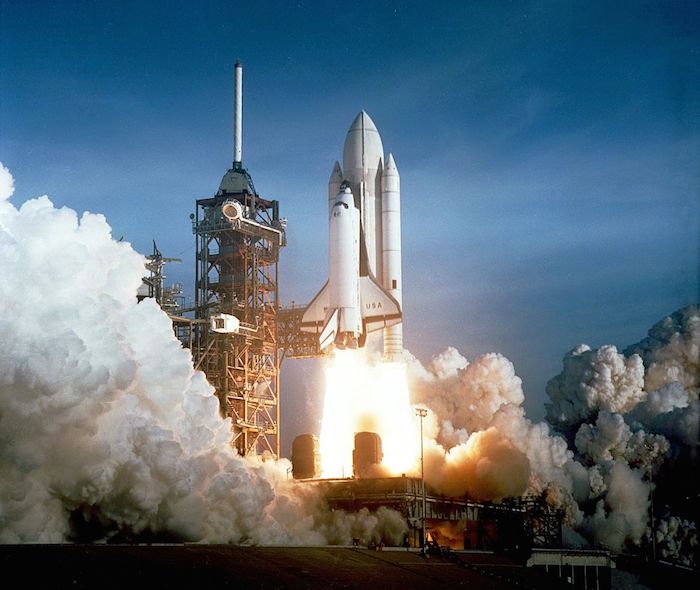
The first launch of the space shuttle finally came on April 12, 1981.
NASA
-
We’d been chatting for the better part of two hours when Chris Kraft’s eyes suddenly brightened. “Hey,” he said, “Here’s a story I’ll bet you never heard.” Kraft, the man who had written flight rules for NASA at the dawn of US spaceflight and supervised the Apollo program, had invited me to his home south of Houston for one of our periodic talks about space policy and space history. As we sat in recliners upstairs, in a den overlooking the Bay Oaks Country Club, Kraft told me about a time the space shuttle almost got canceled.
It was the late 1970s, when Kraft directed the Johnson Space Center, the home of the space shuttle program. At the time, the winged vehicle had progressed deep into a development phase that started in 1971. Because the program had not received enough money to cover development costs, some aspects of the vehicle (such as its thermal protective tiles) were delayed into future budget cycles. In another budget trick, NASA committed $158 million in fiscal year 1979 funds for work done during the previous fiscal year.
This could not go on, and according to Kraft the situation boiled over during a 1978 meeting in a large conference floor on the 9th floor of Building 1, the Houston center’s headquarters. All the program managers and other center directors gathered there along with NASA’s top leadership. That meeting included Administrator Robert Frosch, a physicist President Carter had appointed a year earlier.
Kraft recalls laying bare the budget jeopardy faced by the shuttle. “We were totally incapable of meeting any sort of flight schedule,” he said. Further postponing the vehicle would only add to the problem because the vehicle’s high payroll costs would just be carried forward.
There were two possible solutions proposed, Kraft said. One was a large funding supplement to get development programs back on track. Absent that, senior leaders felt they would have to declare the shuttle a research vehicle, like the rocket-powered X-15, which had made 13 flights to an altitude as high as 50 miles in the 1960s. “We were going to have to turn it, really, into a nothing vehicle,” Kraft said. “We were going to have to give up on the shuttle being a delivery vehicle into orbit.”
.
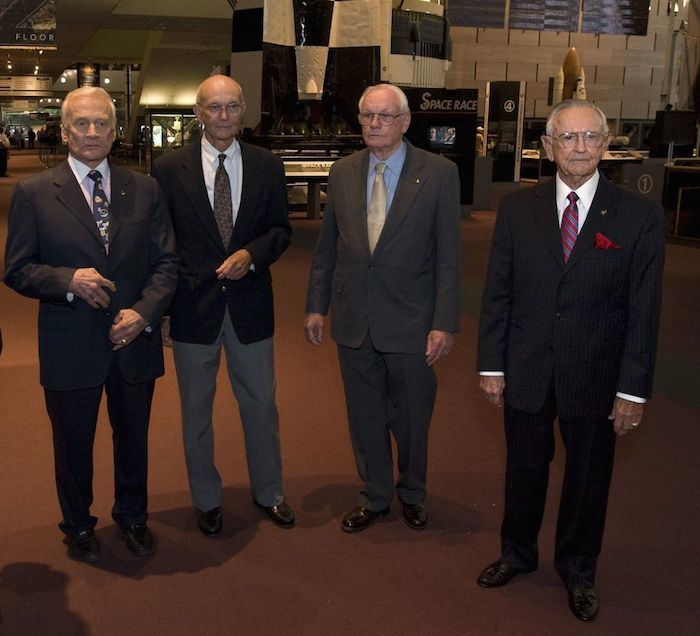
On the eve of the 40th anniversary of the first human landing on the Moon, Apollo 11 crew members, Buzz Aldrin, left, Michael Collins, and Neil Armstrong and NASA Mission Control creator Chris Kraft, right, during their visit to the National Air and Space Museum on July 19, 2009.
NASA/Getty Images
-
Armed with these bleak options, Frosch returned to Washington. Some time later he would meet with Carter, not expecting a positive response, as the president had never been a great friend to the space program. But Carter, according to Kraft, had just returned from Strategic Arms Limitation Talks (SALT) in Vienna, and he had spoken with the Soviet leader, Leonid Brezhnev, about how the United States was going to be able to fly the shuttle over Moscow continuously to ensure they were compliant with the agreements.
So when Frosch went to the White House to meet with the president and said NASA didn’t have the money to finish the space shuttle, the administrator got a response he did not expect: “How much do you need?”
In doing so, Jimmy Carter saved the space shuttle, Kraft believes. Without supplementals for fiscal year 1979 and 1980, the shuttle would never have flown, at least not as the iconic vehicle that would eventually fly 135 missions and 355 individual fliers into space. It took some flights as high as 400 miles above the planet before retiring five years ago this week. “That was the first supplemental NASA had ever asked for,” Kraft said. “And we got that money from Jimmy Carter.”
As I walked out of Kraft’s house that afternoon in late spring, I recall wondering whether this could really be true. Could Jimmy Carter, of all people, be the savior of the shuttle? All because he had been bragging about the shuttle’s capabilities to the Soviets and, therefore, didn’t want to show weakness? This Cold War mystery was now nearly 40 years in the past, but most of the protagonists still lived. So I began to ask questions.
Carter's apathy toward space
At the root of my skepticism was this simple fact—Jimmy Carter was no great friend to the space program or, at least initially, the shuttle. Less than five months after he became president, on the date of June 9, 1977, Carter wrote the following in his White House Diary: “We continued our budget meetings. It’s obvious that the space shuttle is just a contrivance to keep NASA alive, and that no real need for the space shuttle was determined before the massive construction program was initiated.”
On NASA’s own 50th anniversary website, space historian John Logsdon described the Carter presidency in less than flattering terms. “Jimmy Carter was perhaps the least supportive of US human space efforts of any president in the last half-century,” Logsdon wrote.
.
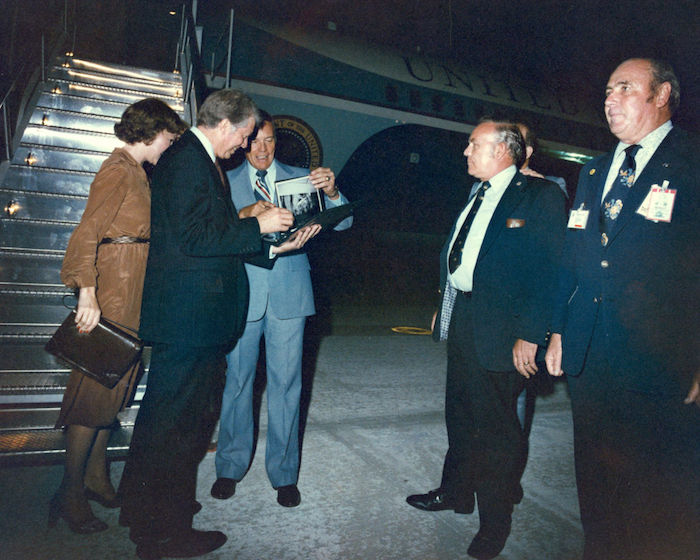
In 1978 President Jimmy Carter visited Kennedy Space Center to check on the space shuttle's progress and participate in an awards ceremony. Here he is greeted by Kennedy Space Center Director Lee Scherer.
-
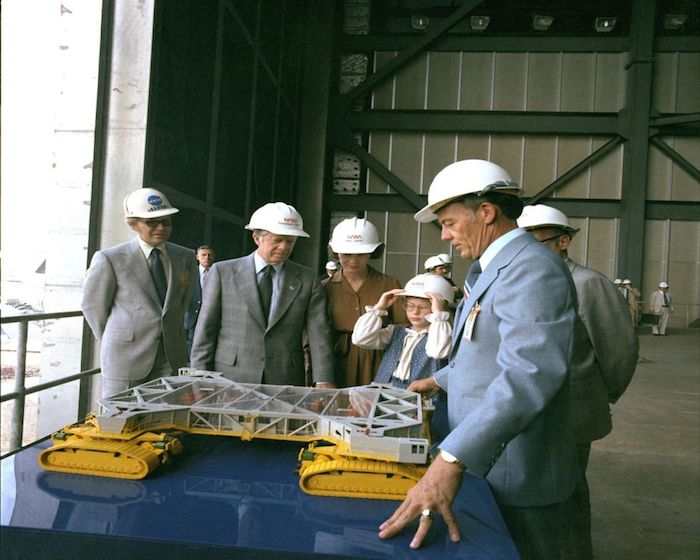
Carter, with wife Rosalynn and daughter Amy, listens to Center Director Lee Scherer explain a model of the crawler transporter during their tour of the Kennedy Space Center.
.
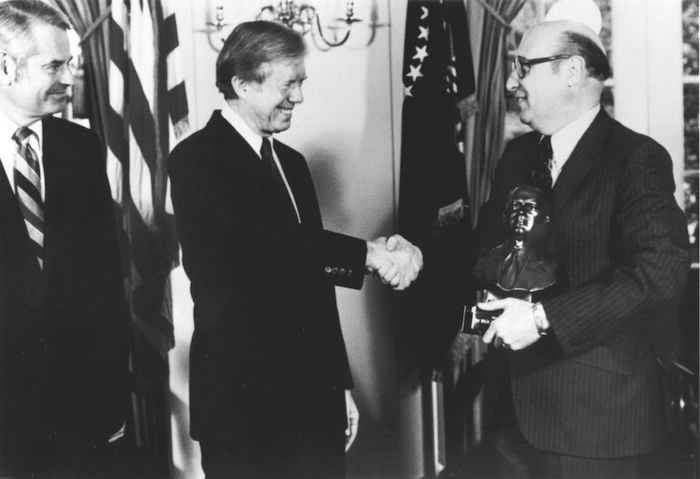
Former President Jimmy Carter, in 1980, presents the National Space Club's Goddard Memorial Trophy to NASA Administrator Dr Robert A Frosch on behalf of the team that planned and executed the Voyager mission to Jupiter and beyond.
-
Then there was Carter’s vice president, Walter Mondale, who in 1972 had called the space shuttle a “senseless extravaganza.” A senator from Minnesota at the time, Mondale had vigorously opposed early funding measures to begin development of the shuttle. His views exemplified those who believed the United States had more pressing needs for its money than chasing the stars.
“I believe it would be unconscionable to embark on a project of such staggering cost when many of our citizens are malnourished, when our rivers and lakes are polluted, and when our cities and rural areas are dying,” Mondale argued during one debate over shuttle funding. “What are our values? What do we think is more important?”
Now these two men were responsible for establishing priorities for the government’s budget and supporting a shuttle that was already years behind schedule as it faced cost overruns of hundreds of millions of dollars. They were going to keep the program afloat?
The shuttle, canceled?
If Kraft is to be believed, cost overruns began really catching up to the shuttle program in 1978, necessitating the big meeting at Johnson Space Center. By then the Enterprise had already made its first free flight in the atmosphere, and the test vehicle was a public relations success. However, the programs to develop the space shuttle’s main engines and its thermal protective tiles remained far behind schedule. It does not seem beyond the realm of possibility that the program might be canceled altogether and that program managers might have worried about this.
John Logsdon, the eminent space historian who has written books about Nixon’s space policy and is working on one about Reagan, told Ars that as costs mounted, the White House Office of Management and Budget suggested to Carter that he might want to cancel the program in 1978 and 1979. This set off a series of White House meetings that culminated in an influential memo to Carter from Brigadier General Robert Rosenberg, of the National Security Council. Titled “Why Shuttle Is Needed,” the Rosenberg memo offered an effective counterpoint to the OMB concerns about cost, according to Logsdon. Written in November 1979, it helped lead Carter to a decision to fund the vehicle.
.
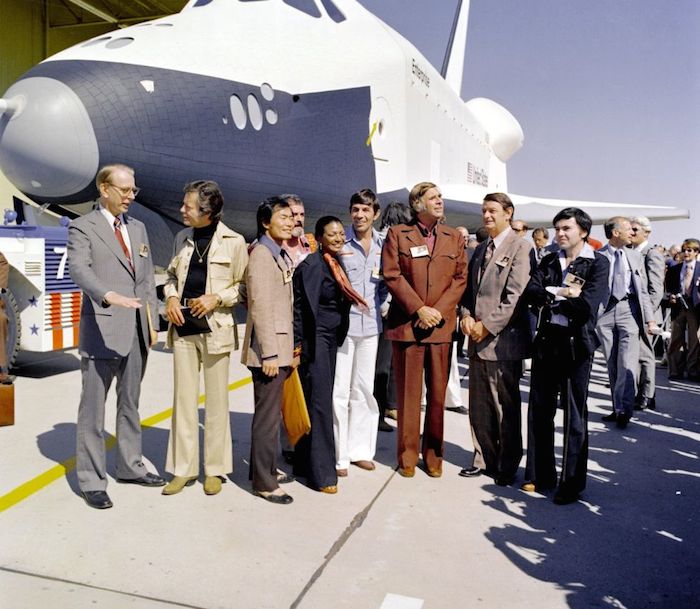
The crew of Star Trek gathers around space shuttle Enterprise in 1977.
NASA
-
“Strong national support and prestige is focused on Shuttle as a means for maintaining space dominance as evidenced by broad user interest and recent space policy statements,” Rosenberg wrote. “Significant delay or abandonment of the Shuttle and manned space capabilities at this time would be viewed as a loss of national pride and direction. The notion that we are forced for short term economic reasons to abandon a major area of endeavor in which we have achieved world leadership at great cost is simply not credible.”
A key player in the shuttle program at this time, Robert Thompson, pushed back on the idea that the shuttle was ever at any real risk of being canceled. Thompson and Kraft are contemporaries. They were classmates at Virginia Tech University in the early 1940s, and later both were original members of the Space Task Group that put together Project Mercury. When Kraft managed flight operations during the Apollo Program, Thompson was in charge of capsule recovery. Ultimately Thompson became the first shuttle program manager in 1970, a post he headed until 1981. Today, Thompson lives about a mile away from Kraft, and his home overlooks the same golf course.
“I never worried an instant about Carter cutting the funding off,” he said in an interview at his dining room table. “You’d have to be an idiot to get up in front of people and say, ‘I’m now going to trash $5 billion even though we’re that close to the finish line, and I’m going to quit human spaceflight.’ Carter was kind of an oddball guy to be president, but he wasn’t stupid.”
So why wasn’t it canceled?
Still, there seem to be valid reasons for concern about a program that would ultimately run three years behind schedule and, according to NASA’s comptroller, about 30 percent over its initial $5.15 billion estimated development cost. Why did Carter remain so steadfastly behind the shuttle? Was it really because Carter valued the shuttle in his arms control discussions with the Soviet Union? The answer appears to be yes.
“It is conceivable that one of his arguments to Brezhnev on why there should be SALT was our ability to use the shuttle to verify the agreements,” Logsdon said. Whereas the president unquestionably felt lukewarm toward spaceflight, he felt conversely strong about arms control. And to verify that the Soviet Union was complying with the treaty, the United States would need a constellation of spy satellites. Back in 1970, to win Department of Defense support at the program’s outset, NASA had redesigned the shuttle to launch national security payloads. Now, that decision paid off.
A book about Carter’s space policy, Back Down to Earth by Mark Damohn, draws this conclusion about a president who liked NASA’s robotic exploration and science but didn’t see the value of humans in space. “The ability of the shuttle to launch arms control verification satellites is what saved it during the Carter administration," Damohn writes. His book does not recount any meetings with Brezhnev. When asked whether Carter might have discussed the shuttle with the Soviet general secretary and whether that might have influenced his decisions, Damohn replied that Kraft’s story is essentially correct except for the part of Carter bragging to Brezhnev. Bragging is not in Carter’s personality, Damohn told Ars.
Another person who could verify or debunk Kraft’s anecdote is Frosch himself, who left NASA in 1981 and remains a senior research fellow at Harvard’s Kennedy School of Government. After I related Kraft’s story, Frosch said he didn’t recall a Brezhnev connection with Carter’s decision to support shuttle funding. “That does not mean it's not true,” he added. “I just don't remember any clear sequence like that. But it's certainly possible if the dates fit together correctly.”
The timeline
Do the dates fit together? For some of the story, yes, and for other parts, no. Kraft recounted fiscal problems plaguing the space shuttle program in 1977 and 1978 that delayed development of the space shuttle’s main engines, thermal protection system, and other flight critical elements. According to TA Heppenheimer’s excellent History of the Space Shuttle, by May of 1979 the shuttle’s costs had already run $830 million over the initial $5.2 billion projected cost.
Moreover, by the time of Kraft’s come-to-Jesus meeting with the shuttle program managers and Frosch at Johnson Space Center, the vehicle had already missed its original March 1978 flight date. Ultimately, the vehicle would not fly until April 12, 1981.
It is also true that the White House provided additional funding when NASA needed it most. The president approved a $185 million supplemental for fiscal year 1979 to address the technical and manufacturing delays, and NASA would receive another $300 million supplemental for the fiscal year 1980 budget. The message from Carter to his OMB officials at this time regarding these supplementals was clear—“find the money.”
What is not consistent with Kraft’s narrative is the notion that Carter bragged about the shuttle to Brezhnev and then felt compelled to follow through with the shuttle’s development for this reason. The 1979 supplemental was formally signed into law by Carter on June 4, 1979, and by then he had already greenlit another supplemental for 1980. These dates are important, because Carter did not meet with Brezhnev in Vienna to sign the SALT II Treaty until June 15.
.
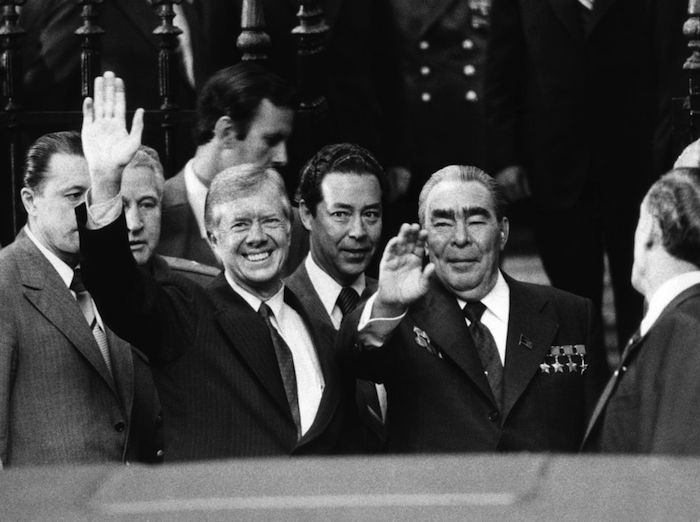
United States President Jimmy Carter, left, and Leonid Brezhnev, First Secretary of the Communist Party of the Soviet Union, welcomed journalists to the Soviet Embassy in Vienna, Austria, on June 17, 1979, on the eve of the signing of the SALT II treaty limiting strategic arms.
-
This means Carter could not have “bragged” about the shuttle and then have funded it. However, this does not mean the talks with Brezhnev had zero influence on Carter’s feelings for the space shuttle during the last 18 months of his turbulent presidency.
By 1980, amid double-digit inflation, spiraling gas prices, and Ayatollah Khomeini’s revolution in Iran, the United States was slipping into another recession. As part of that year’s budget process, the president sought broad spending cuts. Administration officials told NASA to find budget cuts of $460 million to $860 million for the coming fiscal year.
But ultimately, NASA’s budget was spared. Heppenheimer’s book says this happened because “Carter exempted the Pentagon from these cutbacks, which meant that the Defense Department could stand fast in the wake of Moscow’s invasion of Afghanistan. This exemption gave Frosch an opening, as he argued that the shuttle should also be spared from cutbacks on national security grounds.” The president agreed.
Effectively, then, the shuttle program received extra funding in 1980 from a president that did not support human spaceflight and a vice president that adamantly opposed it. The funds came during a recession when the rest of the federal government was undergoing significant budget cuts. That is perhaps a greater marvel than the majestic orbiters themselves.
The ultimate source
For some perspective on all of this, Ars reached out to Carter through Steven Hochman, director of research at The Carter Center. He hadn’t heard the Brezhnev-space shuttle story, but he was happy to assist our reporting by bringing some questions to the 39th president of the United States.
Why did the president ultimately support funding the shuttle in its time of need? “I was not enthusiastic about sending humans on missions to Mars or outer space,” Carter told Ars. “But I thought the shuttle was a good way to continue the good work of NASA. I didn’t want to waste the money already invested.”
Carter also confirmed that he did, in fact, discuss the space shuttle and its capabilities with Brezhnev at the SALT II Treaty meetings in Vienna in June 1979. “I did explain to the Soviets that the space shuttle was peaceful, would not carry weapons, and would always land in the US,” Carter explained.
Finally, Hochman reviewed Carter’s schedule and found that the president had met with Frosch four times at the White House, including a brief discussion on July 11, 1979 with the NASA administrator. This came shortly after the final treaty negotiations in Vienna. Hochman said it would not have been at all surprising if Carter discussed with Frosch that he mentioned the shuttle during the Brezhnev meeting.
From this we can draw a few conclusions—principally that despite some timeline inconsistencies, Kraft’s story appears to be mostly true. The shuttle program was in big trouble and could have been canceled or drastically modified had Carter not stepped in. Moreover, this was not a drawn out process. By all accounts Carter acted swiftly in the shuttle's time of need. Carter’s primary motivation in doing so was enforcing the SALT II Treaty and, critically, Carter discussed the shuttle with Brezhnev during the treaty meetings. Important presidential decisions about the shuttle were made before and after the treaty meetings.
Perhaps what stands out most of all is the lasting, yet almost completely forgotten impact Carter had on this country’s space legacy. Despite just a passing interest in human space exploration, Carter ultimately played a pivotal role in ensuring that the longest-flying US spacecraft in history got built. That decision was instrumental, too, in development of the International Space Station. After all, NASA’s primary purpose for the shuttle was to eventually build an orbital station.
As someone who championed peace during his post-presidency, Carter no doubt would welcome the station’s driving idea of building an international consensus to work together in space. And ironically, after the shuttle finally stopped flying in 2011, America would come to rely on Russia to get into space. Today, we work with the very Cold War enemies with whom Carter negotiated arms treaties, contended with in Afghanistan, and vowed to watch closely from the orbital vehicle he shepherded across the finish line.
Quelle: arstechnica
3956 Views
